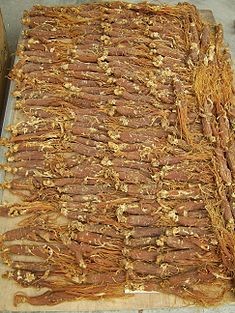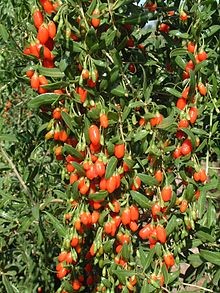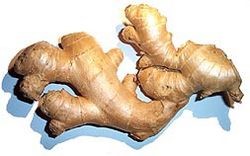There are over three hundred herbs that are commonly
|
|
Wolfberry
Lycium barbarum, Wolfberry (枸杞子) Wolfberry (枸杞子) is grown in the Far East and is grown from shrubs with long vines. The shrubs are covered with small trumpet-shaped flowers, which turn into small, bright red berries. The berries are usually fresh and sometimes used when dried. TCM Information: Species: Lycium barbarum. Pinyin: Gou Qi Zi. Common Name: Chinese Wolfberry. Quality: Sweet, Neutral. Meridians: Liver, Lung, Kidney. Actions: Tonifies kidney and lung yin, tonifies liver blood, tonifies jing, improves vision. Dang Gui Dang Gui (当归, Angelica sinensis or "female ginseng") is an aromatic herb that grows in China, Korea, and Japan. TCM Information: Species: Angelica sinensis. Pinyin: Dang Gui. Common Name: Chinese Angelica Root. Quality: Sweet, Pungent(Acrid), Warm. Meridians: Liver, Heart, Spleen. Actions: Tonify blood, invigorate blood, regulate menstruation, relieve pain, unblock bowels by moistening intestine. |
|
Atractylodes
Atractylodes (白术) is believed to be important in the treatment of digestive disorders and problems of moisture accumulation. TCM Information: Species: Atractylodes lancea. Pinyin: Cang Zhu. Common Name: Atractylodes Rhizome. Quality: Pungent(Acrid), Bitter, Warm. Meridians: Spleen, Stomach. Actions: Strong to dry dampness, strengthens the spleen, induce sweating, expel wind-cold, clears damp-heat from lower jiao, improves vision. Bupleurum Bupleurum (柴胡) is believed to be useful for the treatment of liver diseases, skin ailments, arthritis, menopausal syndrome, withdrawal from corticosteroid use, nephritis, stress-induced ulcers, and mental disorders. TCM Information: Species: Bupleurnum chinense. Pinyin: Chai Hu. Common Name: Hare's Ear Root. Quality: Bitter, Pungent(Acrid), Cool. Meridians: Gallbladder, Liver, Pericardium, San Jiao. Actions: Treats alternating chills and fever, clears lesser yang disorders, relieves liver qi stagnation, raises yang qi to treat prolapse, treats certain menstrual disorders. Cinnamon Cinnamon (桂枝, 肉桂), mostly gui zhi and rou gui, are twigs and bark from large tropical trees. Studies show that cinnamon reduces serum glucose, triglyceride, LDL cholesterol, and total cholesterol in people with type 2 diabetes, and the findings suggest that the inclusion of cinnamon in the diet of people with type 2 diabetes will reduce risk factors associated with diabetes and cardiovascular diseases. TCM Information: Species: Cinnamomum cassia. Pinyin: Gui Zhi. Common Name: Cinnamon Twig. Quality: Pungent (Acrid), Sweet, Warm. Meridians: Heart, Lung, Bladder. Actions: Induce sweating, warms and unblocks channels, unblocks yang qi of the chest, treats dysmenorrhea. Species: Cinnamomum cassia. Pinyin: Rou Gui. Common Name: Cinnamon Bark. Quality: Pungent (Acrid), Sweet, Hot. Meridians: Heart, Kidney, Liver, Spleen. Actions: Tonifies kidney yang, leads fire back to its source, disperses cold, encourages generation of qi and blood, promotes blood circulation, alleviates pain due to cold, dysmenorrhea. Coptis chinensis Coptis chinensis (黄莲) is a rhizome that is one of the bitterest herbs used in Chinese medicine. TCM Information: Species: Coptis chinensis. Pinyin: Huang Lian. Common Name: Coptis Rhizome. Qualities: Bitter, Cold. Meridians: Heart, Large Intestine, Liver, Stomach. Actions: Clears heat and drains damp, drains fire(especially from heart and stomach), eliminates toxicity. Ginger is consumed in China as food and as medicine. Ginger (姜, 薑) is a herb and a spice that is used in Chinese cuisine. There are four main kinds of preparations in Chinese herbology: fresh ginger, dried ginger, roasted ginger, and ginger charcoal, all made of the rhizomes. TCM Information: Species: Zingiber officinalis. Pinyin: Sheng Jiang (生姜, 生薑). Common Name: Fresh Ginger Rhizome. Quality: Pungent(Acrid), Slightly warm. Meridians: Lung, Spleen, Stomach. Actions: Release the exterior, expel cold, warm the middle jiao, relieve nausea, transform phlegm, warm lung to stop coughing, treat toxicity, and moderate the toxicity of other herbs. Species: Zingiber officinalis. Pinyin: Gan Jiang (干姜, 乾薑). Common Name: Dried Ginger Rhizome. Quality: Pungent(Acrid), Hot. Meridians: Heart, Lung, Spleen, Stomach. Actions: Warms the spleen and stomach, restores devastated yang, warms the lung to transform thin mucus, warms and unblocks channels. Licorice The use of the licorice plant (甘草) Glycyrrhiza glabra L. is thought to help treat hepatitis, sore throat, and muscle spasms. TCM Information: Species: Glycyrrhiza inflata or Glycyrrhiza glabra. Pinyin: Gan Cao. Common Name: Licorice Root. Quality: Sweet, Neutral. Meridians: All 12 channels, but mainly Heart, Lung, Spleen, Stomach. Actions: Tonify spleen qi, moisten lung for dry cough, clears heat and fire toxicity, tonifies heart qi to regulate pulse, alleviates spasmodic pain, antidote for toxicity, moderates the effects of harsh herbs. Ephedra Ephedra (麻黄) TCM Information: Species: Ephedra sinica or Ephedra intermedia. Pinyin: Ma Huang. Common Name: Ephedra Stem. Quality: Pungent(Acrid), Slightly Bitter, Warm. Meridians: Lung, Bladder. Actions: Induce sweating and release exterior for wind-cold invasion with no sweating, promotes urination, move lung qi for wheezing, cough or asthma. Peony Peony (白芍, 赤芍) comes in two varieties: bai shao(white) and chi shao (red), the root of the plant is used in both varieties. TCM Information: Species: Paeonia lactiflora. Pinyin: Bai Shao. Common Name: White Peony Root. Quality: Bitter, Sour, Cool. Meridians: Liver, Spleen. Actions: Tonify liver blood, calms liver yang, alleviates flank/abdominal pain from liver qi stagnation or liver and spleen disharmony, preserves yin and adjusts nutritive and protective levels, regulates menses for blood deficiency problem. Species: Paeonia lactiflora or Paeonia veitchii. Pinyin: Chi Shao. Common Name: Red Peony Root. Quality: Sour, Bitter, Cool. Meridians: Liver, Spleen. Actions: Clears heat, cools blood, invigorates blood and dispel stasis to treat irregular menses, dysmenorrhoea, amenorrhea, abdominal pain, and fixed abdominal masses. Rehmannia Rehmannia (地黄) is a root where the dark, moist part of the herb is used. TCM Information: Species: Rehmannia glucinosa. Pinyin: Sheng Di Huang. Common Name: Chinese Foxglove Root. Qualities: Sweet, Bitter, Cold. Meridians: Heart, Kidney, Liver. Actions: Clears heat, cools blood, nourishes yin, generates fluids, treats wasting and thirsting disorder. Species: Rehmannia glucinosa. Pinyin: Shu Di Huang. Common Name: Chinese Foxglove Root Prepared with Wine. Qualities: Sweet, Slightly warm. Meridians: Heart, Kidney, Liver. Actions: Tonifies blood, tonifies liver and kidney yin, treats wasting and thirsting disorder, nourishes jing. Rhubarb Chinese rhubarb depicted by Michał Boym Rhubarb (大黄) is a large root and was once one of the first herbs that was imported from China. TCM Information: Species: Rheum palmatum, Rheum ranguticum, or Rheum officinale. Pinyin: Da Huang. Common Name: Rhubarb Root and Rhizome. Quality: Bitter, Cold. Meridians: Heart, Large Intestine, Liver, Stomach. Actions: Purge accumulation, cool blood, invigorate blood, drain damp-heat. Salvia Salvia (丹参) are the deep roots of the Chinese sage plant. TCM Information: Species: Salvia miltiorrhiza. Pinyin: Dan Shen. Common Name: Salvia Root. Qualities: Bitter, Cool. Meridians: Heart, Pericardium, Liver. Actions: Invigorate blood, tonify blood, regulate menstruation, clear heat and soothe irritability. |



